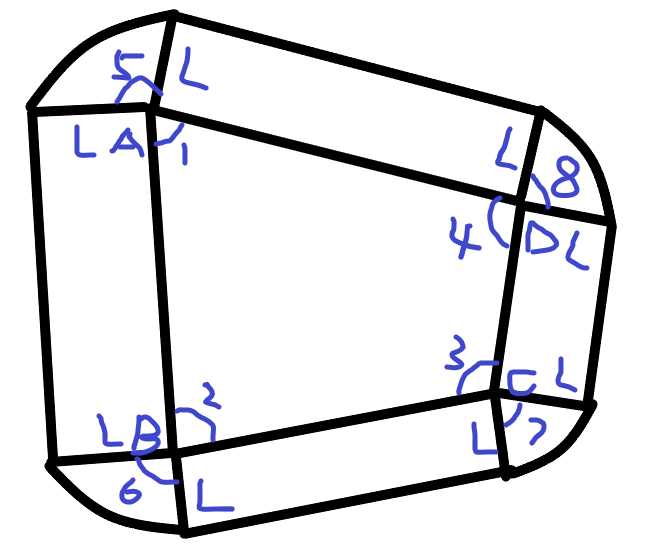POJ 1113 Wall (凸包 + 思维)
Posted willems
tags:
篇首语:本文由小常识网(cha138.com)小编为大家整理,主要介绍了POJ 1113 Wall (凸包 + 思维)相关的知识,希望对你有一定的参考价值。
题目:传送门
题意:有一个 n 多边形城堡,先需在城堡外建围墙,使得围墙到城堡的距离不得小于 L,且围墙的周长最小。
思路:答案就是凸包周长 + 半径为 L 的圆的周长。 证明

A、B、C、D四个点,每个点都有 360 度, 然后,角1、2、3、4构成多变形的内角和为 360度,然后每个点,又要减去两个90度,那么剩下的就是圆心角5、6、7、8,它们的和为 4 * (360 - 180) - 360 = 360,刚好是一个圆。推广到任意多边形也是类似的。
#include <iostream> #include <stdio.h> #include <string.h> #include <algorithm> #include <queue> #include <map> #include <vector> #include <set> #include <string> #include <math.h> #define LL long long #define mem(i, j) memset(i, j, sizeof(i)) #define rep(i, j, k) for(int i = j; i <= k; i++) #define dep(i, j, k) for(int i = k; i >= j; i--) #define pb push_back #define make make_pair #define INF INT_MAX #define inf LLONG_MAX #define PI acos(-1) using namespace std; const int N = 5e4 + 5; struct Point { double x, y; Point(double x = 0, double y = 0) : x(x), y(y) { } /// 构造函数 }; typedef Point Vector; /// 向量+向量=向量, 点+向量=向量 Vector operator + (Vector A, Vector B) { return Vector(A.x + B.x, A.y + B.y); } ///点-点=向量 Vector operator - (Point A, Point B) { return Vector(A.x - B.x, A.y - B.y); } ///向量*数=向量 Vector operator * (Vector A, double p) { return Vector(A.x * p, A.y * p); } ///向量/数=向量 Vector operator / (Vector A, double p) { return Vector(A.x / p, A.y / p); } const double eps = 1e-10; int dcmp(double x) { if(fabs(x) < eps) return 0; else return x < 0 ? -1 : 1; } bool operator < (const Point& a, const Point& b) { return a.x == b.x ? a.y < b.y : a.x < b.x; } bool operator == (const Point& a, const Point &b) { return dcmp(a.x - b.x) == 0 && dcmp(a.y - b.y) == 0; } double Dot(Vector A, Vector B) { return A.x*B.x + A.y*B.y; } /// 点积 double Length(Vector A) { return sqrt(Dot(A, A)); } /// 计算向量长度 double Angle(Vector A, Vector B) { return acos(Dot(A, B) / Length(A) / Length(B)); } /// 向量A、B夹角 double Cross(Vector A, Vector B) { return A.x*B.y - A.y*B.x; } /// 叉积 Point P[N], Q[N]; int ConvexHull(Point* p, int n, Point* ch) { sort(p, p + n); int m = 0; rep(i, 0, n - 1) { while(m > 1 && Cross(ch[m - 1] - ch[m - 2], p[i] - ch[m - 2]) <= 0) m--; ch[m++] = p[i]; } int k = m; dep(i, 0, n - 2) { while(m > k && Cross(ch[m - 1] - ch[m - 2], p[i] - ch[m - 2]) <= 0) m--; ch[m++] = p[i]; } if(n > 1) m--; return m; } int main() { int n, L; scanf("%d %d", &n, &L); rep(i, 0, n - 1) scanf("%lf %lf", &P[i].x, &P[i].y); n = ConvexHull(P, n, Q); double ans = 0; rep(i, 0, n - 1) { ans += Length(Q[(i + 1) % n] - Q[i]); } ans += 2.0 * PI * 1.0 * L; printf("%d ", (int)(ans + 0.5)); return 0; }
以上是关于POJ 1113 Wall (凸包 + 思维)的主要内容,如果未能解决你的问题,请参考以下文章